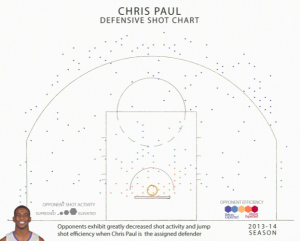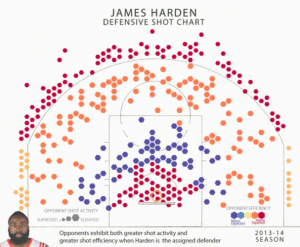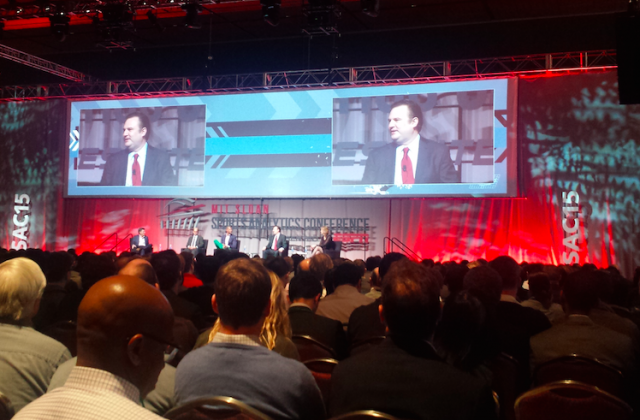Sloan 2015 – the stupidly long roundup – Part 1
Boston.
Stupidly cold Boston.
Six below by day, 22 below by night.
That’s in Celsius.
Temperatures where one realises the significant difference between the required coat and a duvet is the zipper.

Snow piled high in the streets of Boston on the weekend of the 2015 Sloan conference.
I was there for the 2015 Sloan Sports Analytics Conference, a Mecca for many in the sports analytics industry or even those simply with an interest in that side of sport. Well, an interest and several hundred dollars to spend on a ticket. Over three thousand attendees attending panels and presentations over two long days. Longer if one counts the Soccer Analysts meet-upi on the Thursday night.
Time for a bounce around the conference’s two days, roughly spaced out by time. This is not a formal piece; I did one of those for the Irish Times.
This is a blog. A proper one.
There will be snark.
Friday…
First panel: Innovators and Adopters. A love poem to analytics featuring Michael Lewis, author of Moneyball and seminal New York Times article on an undervalued NBA player; Daryl Morey, Houston Rockets GM and noted numberphile; Shane Battier (said undervalued NBA player who played for the Rockets before winning two NBA titles with the Miami Heat); Jeff Van Gundy, ESPN commentator and former Rockets coach.

The opening panel of the 2015 Sloan Sports Analytics Conference (face of Daryl Morey, Houston Rockets GM on the big screens). Photo Credit: Andy McGeady.
You might have noticed a certain theme.
“It was his destiny to be here” said Morey of Battier. Lewis would describe him as the “lab rat who actually understood the experiment as much as the scientist”. While accepting that he had been seemingly able to process more information than the average NBA player Battier said that desire to do the little things started when he was in high school: “I figured out – when I help teams win, people like me”.
“I was able to create space for most players” said Battier, a little further into the discussion. “That’s what every coach is trying to do. When you have supremely talented players… you must allow them to operate in space. And so, when you have space-creators – that was basically my main job – even though I didn’t do anything on paper my job was essential because that foot of space I was creating for LeBron James on a drive was the difference between him completing the play and him getting stopped”.
When Sponsorship Doesn’t Work
After twenty minutes I wandered off to another stage. It’s like a music festival in that regard – a timetable with multiple people on simultaneously that you might want to see. I wanted to catch Michael Niemeyer, Bayern Munich analyst. Niemeyer was there with tech giants SAP, sponsors of the Technology Amplifies Success session.
There are plenty of conference sponsors – it’s the conference industry way. Adding a sponsor to a panel does not necessarily signal doom. But I’d suspected that this panel might not be the most journalistically disciplined I’d ever witnessed given the moderator was described as Global Vice President, Strategic Sales, SAP.
For the portion of time I was there Niemeyer gave the odd glimpse inside the tent but apart from that it had the feel of a glitzy PR session. Soft sales pitch dressed up in a sports jersey.
Back to Hoop
Shane Battier’s second panel on the trot. Basketball Analytics, along with the entertaining Mike Zarren (Boston Celtics assistant GM), former NBA coach Mike D’Antoni and WNBA player Sue Bird. A busy man, Battier, rocking some fantastic green trousers.
In my notes from this session I had two lines in bold and highlighted in yellow:
Defensively, it helped me.
Offensively, it took away all my creativity.
I went back to the tape afterwards.
“Defensively I think [analytics] helped my career, and my life, immensely. Offensively, I lost all my creativity. I really did. I became a player that just shot threes. And my last two years in the NBA I think I made one non-paint two point jumper”, said Battier.
That’s one of those Sloan moments. You’re there listening to guys talk about a sport that is certainly not your own and out pops something that mirrors what others have said about something close to home. Rugby, in this instance. I caught up with Battier after the session to ask him to expand on the point.
“I believe that the true genius of offense is creativity. And the instincts. And that’s what makes LeBron James great; Kevin Durant – the truly great scorers – is their ability to improvise and not overthink. But on defense it’s just the opposite. You have to have instincts obviously as a defender but if you’re able to have a rational plan that you implement to give yourself the best shot of guarding somebody it pays to be more aware and more calculating.
“I’m a calculating person so defense has always come easier to me; so if I knew where a player wanted to go when he caught the ball on a certain spot on the floor and I could prepare my positioning to take away that I know I’m shaving off percentage points and giving myself a better chance to survive and win that singular possession. It’s pretty interesting how they’re polar opposites in that regard.”
Can overcoaching actually nullify attacking strengths, I asked him.
“In basketball, yes” said Battier. “In basketball I believe that usually the most aggressive team wins. And you cannot be aggressive without being instinctual”.
I stayed for the whole thing. The whole hour. The significant of this can be measured relative to the fact that I can count the number of hour-long stretches I’ve spent watching NBA games on two hands.
“Defensively I think [analytics] helped my career, and my life, immensely. Offensively, I lost all my creativity. I really did. I became a player that just shot threes. And my last two years in the NBA I think I made one non-paint two point jumper.”
– Shane Battier, former NBA player and current ESPN analyst
Football. Real Football.
And on to Soccer Analytics: Niemeyer again with Chris Anderson (co-author of The Numbers Game), Gus McNab (Opta/Perform Group) and Ravi Ramenini (Seattle Sounders performance analyst).
“These events are kind of schizophrenic” said Anderson, “kind of like a revival meeting while we also complain things aren’t going fast enough”.
Anderson said this tongue in cheek, but it was neither the first nor last religious reference at Sloan. Some panelists (and moderators) referred to a “belief” in analytics as if it was driven by some divine sky-pixie. But there have been pseudo-holy wars in this area of life, in baseball in particular. Blind faith in “that’s the way it’s always been” versus dogmatic “if we can’t prove it with data it doesn’t exist”. An argument overly-simplistically framed as Scouts vs Stats, as manifested in the 2012 MVP debate between Triple Crown winning slugger Miguel Cabrera and the better all-around player Mike Trout, who the advanced stats loved.
The other quote I scribbled downii was by Niemeyer on data collection.
“Most of the companies that collect dataiii do it for the media. So they’re asking the wrong people and, most of the time, asking the wrong questions”.
Scribble, scribble, scribble.
“If we analyse an opponent we still have to do it by ourselves”, said Niemeyer. “To look at the last ten games and go, ok – what were their tactical lineups? There are companies that do this – collect this data – but they’re doing it for the media. And the media just need content. It doesn’t have to be true“.
That last bit is in bold. It was Niemeyer’s drop mic moment. Genuine laughter all around. Even through the sound of the crisp bag. It’s not that it’s true or false – that doesn’t matter. It was what he very obviously genuinely felt.
Opta’s Gus McNab was sitting directly beside Niemeyer. After taking that shot manfully he would later mention the difficulty for the media in analysing intent. In the NFL a couple of days before Monday night football the head coach will take a fairly long conference call with the commentators, said McNab. It’s viewed as assistance for the media to help them present more informed analysis such as what was supposed to happen on a particular play. A limited drawing back of the curtain while not giving away the farm. That concept would be completely foreign to any coach in the UK and Ireland.
The media just need content. It doesn’t have to be true.
– Michael Niemeyer, Bayern Munich.
Is Analytics Taking The Joy Out Of Sports?
Good question. A fair one. And the name of my next panel. There is a cadre in the sports-watching community that has an intense dislike of the creep of stats into sports coverage. Battier (again), Brian Burke (the NFL one) and Ben Alamar (ESPN’s Director of Production Analytics). John Anderson (ESPN Sportscenter) hammed it up as luddite moderator.
Alamar made a good point about false analytics, saying “any time we see data now we call it analytics”. He said any time you talk about analytics there must be information behind it, otherwise it’s just a bunch of numbers.
While some fans want to know more and more there is sometimes merit in not knowing. NFL games are often over long before we think they are, said Burke. But the announcers do a great job of keeping us interested. Sometimes analytics can rob us of that drama too early.
Soccer Research, Golf Research
Time for a couple of research presentations, at which you see many different people. Media and amateur enthusiasts, talking heads and panelistsiv. I wandered into Patrick Luceyv‘s talk on Improved Shot Prediction in Soccer and onwards to Impact of Pressure on Performance, this year’s CDW Shotlink Prize winning paper presented by economics professors Daniel Hickman and Neil Metz. The objective was to quantify choking using data from the final hole of every PGA tournament over an eight year stretch. That’s almost 24000 observations.
This golf presentation should have been better. There’s a rich amount of data to be used – prize money, points away from Ryder Cup selection, Strokes Gained Putting – but the presentation needed more life. More certainty. Watching it along with a member of the *cough* Las Vegas sports investment community who had been intrigued about what they might have uncovered I’m not sure they really drilled their point home.
Counterpoints
It was standing room onlyvi in the Research Paper room for this exciting presentation. A continuation of the work of Kirk Goldsberry and Luke Bornn, students Alexander Franks and Andrew Miller talked the large crowd through some of the group’s latest work based around quantifying defensive impact in the NBA.

Chris Paul – this is a good defensive shot chart. Credit: Counterpoints: Advanced Defensive Metrics for NBA Basketball (Franks/Miller/Bornn/Goldsberry)
Shot suppression. Shot disruption. Defensive shot charts showing how effective NBA players are at suppressing shots in various areas of the court and disrupting those that are attempted. As well as static graphics they also included an animation demonstrating how their model estimated which player (or players) were responsible for defending a player at any one time.

James Harden. This is not as good a defensive shot chart. Credit: Counterpoints: Advanced Defensive Metrics for NBA Basketball (Franks/Miller/Bornn/Goldsberry)
Fascinating stuff.
Edward Tufte – The Thinking Eye
Friday’s talks would end in a blacked-out hall. And a wonderful experience. If you’ve ever had the chance to see Edward Tufte speak you’ll know of this. He had set a high bar last year in his first appearance at Sloanvii and was, if marking with particularly red ink, just shy of reaching it again.
But the Tufte bar is higher than most.

The Swiss mountain maps, cited by Edward Tufte as perhaps the gold standard of data visualisation.
The visualisation guru, now 72 years old, seeks clarity and simplicity in the visual presentation of data. To present data effectively it helps to see clearly and to understand how we see. The Thinking Eye is powerful.
Wide-eyed is good. When you arrive in a new place and see all sorts of things, for a few days at least. “To see with vacation eyes”, said Tufte. He would repeat it often.
Serenity is essential; a condition under which all brainpower is devoted to The Thinking Eye.
“In doing creative work do not start your day with addictive time vampires like the New York Times or Twitter” said Tufte.
They clog up the short term memory.
“Instead, begin with your work”.
That hour was wonderful and beautiful, both peaceful and thought-provoking. Last year was Tufte’s first to speak at Sloan. May he stay forever on the list.
“In doing creative work do not start your day with addictive time vampires like the New York Times or Twitter.
…
Instead, begin with your work.”
– Edward Tufte
Next, Saturday.


Comments
3 Responses to “Sloan 2015 – the stupidly long roundup – Part 1”Trackbacks
Check out what others are saying...[…] Related Reading: The Stupidly Long Sloan Roundup – Part 1 […]
[…] The Stupidly Long Sloan 2015 Roundup Part 1 […]
[…] Sloan 2015 – the stupidly long roundup – Part 1 […]